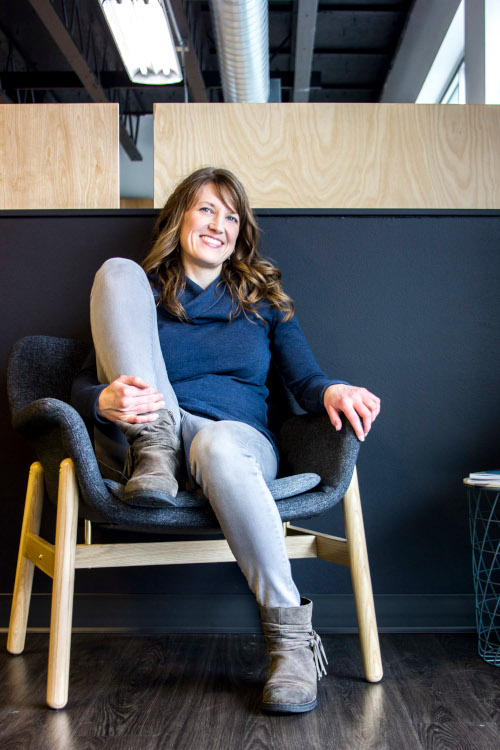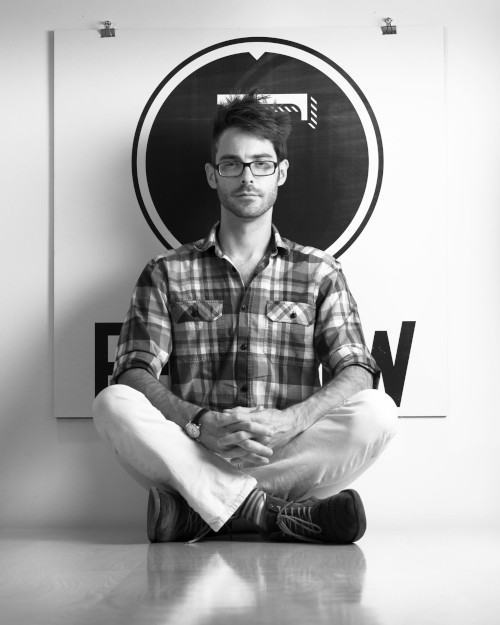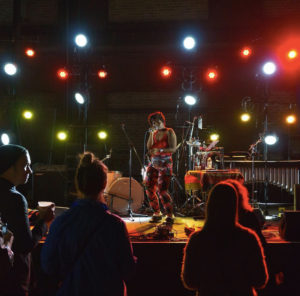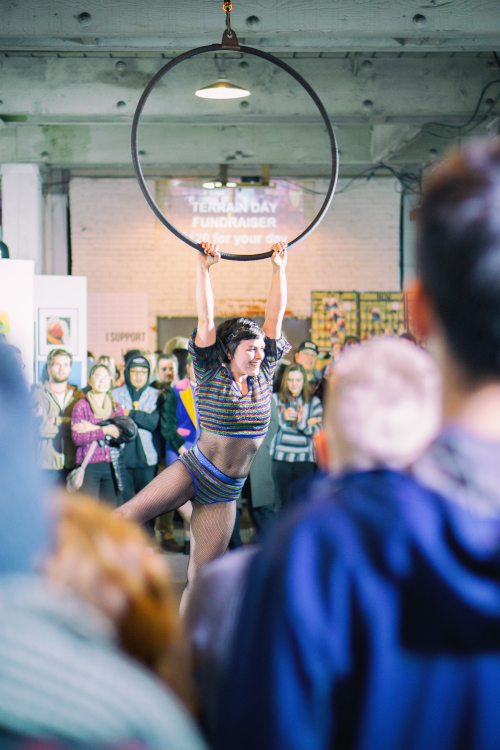A new crop of activists is helping the arts thrive in Lilac City

Ten years ago, Spokane, Washington—otherwise known as the Lilac City—had an inferiority complex. So says Brooke Matson, an educator, published poet, and longtime graphic designer. Matson left Spokane for Seattle in 2014 but was lured back a year later. The prospect of helping lead an arts-based nonprofit, despite being fatigued by trying to make ends meet in Seattle, was the catalyst.
“You can live [in Spokane] and afford to make art,” says Matson, who is executive director of Spark Central, a unique youth-oriented activity center. Spark Central offers free classes, tools, and support for creative endeavors ranging from computer coding to drawing and writing.
Like Matson, Alan Chatham grew up in Spokane, but left in 2003. He served in the U.S. Army, went to college in California, and worked in various creative and technology driven jobs (sculpture studio technician, programmer, software developer, researcher). When he returned to Spokane in 2013, he launched Laboratory, a residency and exhibition space for interactive art. Laboratory is similar in concept to Tokyo’s much-heralded TeamLab Borderless interactive art museum and Seattle’s MoPop.
“I don’t feel a need to catch up to Seattle,” says Chatham, who marvels that Spokane offers more events than he can attend. “The local culture is thriving to the point that it’s impossible to keep track of all the events.”
My mom’s generation, and I’m sure generations before, were told this self-fulfilling narrative,” Ewing says. “That if you were going to be successful you were going to do it anywhere but Spokane.
Terrain, a nonprofit organization at the center of Spokane’s arts scene, was the brainchild of Ginger Ewing and Luke Baumgarten, two Spokane-area natives who never left. Both have heard plenty of criticism about their hometown over the years. Ewing serves on both the Spokane Arts Commission and the Washington State Arts Commission, while Baumgarten is a former arts reporter for the Pacific Northwest Inlander, as well as the founder of Fellow Coworking.
“My mom’s generation, and I’m sure generations before, were told this self-fulfilling narrative—” Ewing says. “That if you were going to be successful you were going to do it anywhere but Spokane.”
“The big thing for me was hearing from all these artists that there was no community in Spokane,” says Baumgarten. He reasoned that “many artists could easily make community if they got in the same room and got to know each other.”

And Spokane is full of talent, according to Ewing and Baumgarten, who met in 2007. At the time, Baumgarten was writing a piece about Spokane’s up-and-coming 20- and 30-something crowd for the Inlander and Ewing was a curator for cultural literacy at the Northwest Museum of Arts & Culture (MAC). In 2008, they and a group of like-minded contemporaries co-founded Terrain. It has since earned well-deserved ink for its elevation of Spokane’s musical and visual arts scene.
The challenge has been keeping and attracting talent in Spokane, while creating a sustainable community that celebrates the contributions of the creative industry. It was a tall order for this new crop of arts activists who set out to provide exposure, exhibition space, instruction, and support for the city’s growing art scene.
In 2018 Terrain celebrated ten years of producing their signature annual event, also named Terrain. The wildly popular two-day extravaganza, which was attended by more than 8,000 fans this year, showcased 239 artists, 14 poets, 5 performance art groups, 13 bands, 6 site-specific installations, and 6 films. Visitors spent nearly $30,000 on art, not including ticket sales for the preview night.
Let that sink in: $30,000…over two nights…on art! And that’s no fluke. Bazaar, Terrain’s springtime marketplace for local art and hand-crafted goods– garnered five times that much–nearly $150,000 in one day. Terrain is certainly filling a niche, and proves the old cliché “if you build it, they will come.”
Terrain, the wildly popular two-day extravaganza, was attended by more than 8,000 fans this year, showcased 239 artists, 14 poets, 5 performance art groups, 13 bands, 6 site-specific installations, and 6 films. Visitors spent nearly $30,000 on art.
While those dollar amounts might seem a pittance to those familiar with Portland’s PDX Contemporary Art or Seattle’s Greg Kucera Gallery, the success of Terrain and other arts organizations in Spokane has been a game-changer for a city with a sleepy reputation.
With a metropolitan population of 564,000, Spokane’s history parallels many of its larger cousins across western North America: rooted in conquest, flooded by westward-bound settlers, and driven by natural resource extraction including mining and timber. The arrival of the Northern Pacific Railroad in the late nineteenth century fueled Spokane’s commerce, manufacturing, and agriculture. Like many boom towns, this eastern Washington city flourished—until it didn’t.
Once the state’s apple capital before being bumped by the Tri-Cities, Spokane has struggled against economic headwinds, urban sprawl, and vacillating business interests. On the plus side, it has amenities typically found in much larger cities: an international airport; top-notch medical facilities; two community colleges and three universities; a burgeoning downtown core gaining attention for a thriving coffee, craft beer, and culinary scene. A recent article in Forbes praised Spokane’s affordable cost of living, which is about 2 percent below the national average.
Forbes ranks Spokane 58th out of 200 cities for business and careers, 55th in cost of doing business, and 94th in job growth. Sperling Best Places to Live awards a miserly two out of five stars to Spokane, citing crime, harsh winters, and low ethnic diversity. But Sperling does applaud Spokane’s thriving downtown, educated populace, and strong arts and culture scene.
In 1974 Spokane hosted the Worlds Expo and was the smallest city ever to do so. It was a boon to the city and its artists, but 30 years later, the city’s arts funding experienced the first of many budget contractions.
Spokane’s arts base includes a symphony and numerous theatrical organizations and venues including The Bing (named for crooner Bing Crosby, who grew up in the Lilac City), the restored Martin Woldson Theater at The Fox, the Civic Theater, and the newly renovated 2,700-seat First Interstate Center of the Arts. The city also boasts an international film festival, a literary festival, and a well-established First Friday art walk tradition.

Even so, the visual arts have faced ongoing challenges in Spokane. In 1974 Spokane hosted the Worlds Expo and was the smallest city ever to do so. It was a boon to the city and its artists, but 30 years later, the city’s arts funding experienced the first of many budget contractions. By 2012, more cuts and a philosophical shift led to the desiccation and eventual elimination of the city’s arts commission. This called into question the stewardship of the city’s 230-piece public art collection, which includes works by Harold Balazs, Sherman Alexie, and George Tsutakawa.
Like many cities and towns, the citywide art walk concept is deeply entrenched, yet dedicated spaces are limited or constrained. The city’s Chase Gallery dictates that artwork is curated so as not to invoke controversy—for example, there’s a longstanding practice of excluding nudity. The Northwest Museum of Arts & Culture (formerly Eastern Washington State Historical Society and protector of an extensive collection of Columbia Plateau tribal artifacts) is required to balance regional, historical, and educational programming—leaving little room for new, local art. Much of the onus for exhibiting contemporary art falls to places like Chatham’s Laboratory or Saranac Art Projects, a nonprofit arts collective that features work by many of the region’s academics and which is one of the few places in the Inland Northwest to see performance, video, and installation art.
Geography also plays a part in making things complicated. Spokane’s handful of arts venues—both permanent and those associated with art walks—are spread across 60 square miles, preventing a cohesive community .
Spokane’s artists also are separated philosophically, says Ewing. She notes that Terrain was designed in part to counter the silos— between emerging and established artists, between traditional media and contemporary, and between the so-called crafts versus fine art. Terrain’s events have crossed those boundaries and helped build a community in Spokane among a diverse assortment of artists.
Collaborations have been another key to re-imagining Spokane’s visual arts scene. At Spark Central, Matson has avoided working in film since Spokane’s Community-Minded Television already does that very well. “It just makes no sense to compete in this small environment,” says Matson.
Instead, Matson reached out to the organizations like the Salish School of Spokane, Chatham’s Laboratory, the civic theater, and the city’s Spokane Arts—all working together to develop “Dial a Story,” phone booths in which people can hear stories about the people and events that shape life in Spokane.
In 2014, Laboratory cross-pollinated with Terrain to produce an endeavor called Window/Dressing, which placed more than 40 art installations in about a dozen empty business storefronts. That in turn spawned Creative Enterprise, an incubator program that provides professional development and business resources for start-ups and creative businesses looking to expand.
In 2014, Terrain collaborated with the Spokane Symphony to create “Uncharted,” a mashup of musical genres—pairing hip hop and Handel, for instance—at once elevating and challenging musicians from both organizations.
Terrain, Laboratory, and Spark Central are just a few of the players reinvigorating the arts in Spokane. Despite a few rocky years of continually-transitioning leadership, Spokane Arts has redoubled its efforts to support and promote visual arts. Projects include public murals, an arts awards night, grant-writing assistance, and increased recognition for under-represented populations, including people of color and Native Americans.

Although research has tended to focus on the soft benefits of a strong arts and culture scene (improved quality of life, empathy for others, enriching the human experience) organizations like Americans for the Arts are increasingly focusing on the economic impact of non-profit arts organizations. A 2015 report says these organizations generated $166.3 billion of economic activity in the US.
Spokane’s business leaders have taken notice, as the potential to becoming a tourist destination continues to grow. In just one example the city’s the former slogan “Near Nature, Near Perfect,” was geared toward the outdoors, while its new tagline elevates the role of creative industries: “Creative by Nature.”
As for the next ten years, Ewing and Baumgarten are paying more attention the Inland Northwest beyond Spokane. “One of the things that’s next for us is creating more regional and statewide connections,” says Baumgarten.
Describing what she sees as a watershed moment for Spokane, Ewing notes that it’s important to continue advocating for buy-in: from the city, its residents, from regional businesses.
And as more people flee increasingly expensive cities like Seattle and Portland for Spokane, protecting artists from the inevitable growth and price increases will be a challenge. A big priority for Ewing is “preserving cultural space. As the influx happens, not pushing out creatives that make Spokane a desirable place to begin with.”
All photos courtesy of Terrain, Spark Central, and Laboratory.
CORRECTION: December 3, 2018. This article was corrected to include the correct name for the Spokane Arts Department, and to remove a claim that the city’s Chase Gallery prohibits nudity in the art displayed there. According to Spokane Arts, there is currently no such rule.
Carrie Scozzaro has built a life using words and images as an artist, designer, teacher and writer. She is a longtime contributor on art, education, culture, food, and northwest life for the Inlander, an alt-weekly out of Spokane, as well as a frequent contributor to Sandpoint Magazine, Western Art & Architecture, Big Sky Journal, Edible Idaho, and Montana Senior News. Carrie currently serves as the art director for a K-5 arts and humanities public school in north Idaho.
If you appreciate informative articles like this about people making a difference in the Pacific Northwest, please consider becoming a supporting reader of Cascadia Magazine. We depend on the generous financial support of readers to pay our writers and photographers a fair rate for their work. Visit our donate page to make a contribution.
And if you’re already a supporting reader, thank you!
